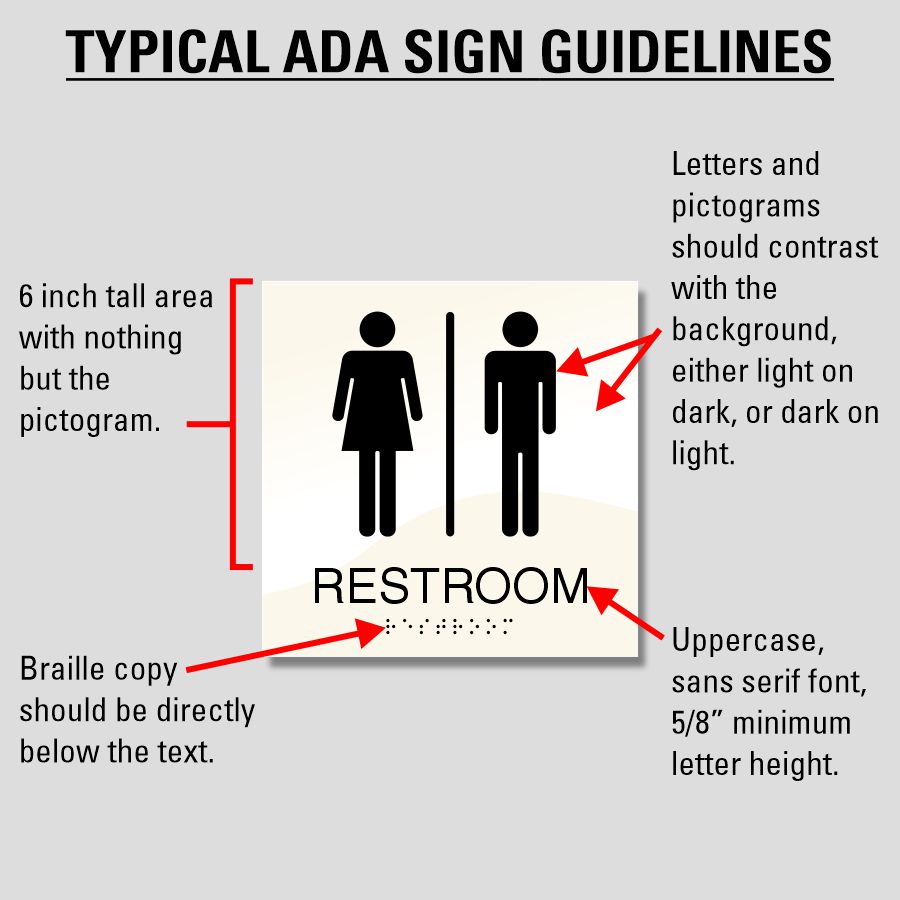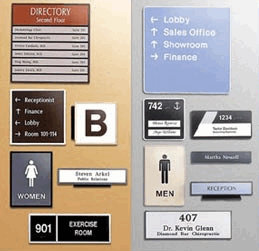A Comprehensive Overview to Choosing the Right ADA Signs
A Comprehensive Overview to Choosing the Right ADA Signs
Blog Article
Exploring the Key Functions of ADA Signs for Improved Availability
In the realm of accessibility, ADA indicators serve as quiet yet powerful allies, guaranteeing that rooms are navigable and comprehensive for people with specials needs. By integrating Braille and responsive aspects, these indications break obstacles for the aesthetically impaired, while high-contrast color schemes and legible fonts provide to diverse aesthetic requirements.
Relevance of ADA Compliance
Making sure compliance with the Americans with Disabilities Act (ADA) is important for fostering inclusivity and equal access in public areas and workplaces. The ADA, established in 1990, mandates that all public centers, companies, and transport solutions accommodate people with disabilities, guaranteeing they appreciate the very same legal rights and chances as others. Compliance with ADA standards not just fulfills legal responsibilities however additionally improves an organization's online reputation by demonstrating its dedication to variety and inclusivity.
Among the crucial elements of ADA conformity is the execution of accessible signs. ADA signs are developed to make sure that individuals with specials needs can quickly navigate via spaces and buildings. These indications must comply with certain standards regarding dimension, font style, color contrast, and positioning to assure visibility and readability for all. Appropriately carried out ADA signage aids remove barriers that individuals with impairments commonly come across, thereby promoting their freedom and confidence (ADA Signs).
Additionally, sticking to ADA laws can minimize the danger of prospective penalties and legal repercussions. Organizations that fail to abide by ADA standards might encounter suits or penalties, which can be both damaging and financially troublesome to their public photo. Thus, ADA conformity is essential to cultivating a fair atmosphere for every person.
Braille and Tactile Components
The unification of Braille and responsive elements right into ADA signs personifies the concepts of accessibility and inclusivity. It is typically put beneath the equivalent text on signage to make sure that individuals can access the details without visual aid.
Tactile aspects expand past Braille and consist of increased icons and characters. These parts are created to be discernible by touch, enabling individuals to identify room numbers, bathrooms, exits, and various other crucial locations. The ADA sets details guidelines pertaining to the dimension, spacing, and positioning of these responsive aspects to maximize readability and ensure consistency throughout various atmospheres.

High-Contrast Shade Plans
High-contrast color pattern play an essential function in enhancing the presence and readability of ADA signage for people with visual impairments. These plans are vital as they optimize the distinction in light reflectance between message and background, making certain that signs are easily noticeable, also from a distance. The Americans with Disabilities Act (ADA) mandates making use of particular color contrasts to suit those with restricted vision, making it a crucial facet of compliance.
The efficiency of high-contrast shades hinges on their ability to attract attention in numerous lights problems, including poorly lit environments and locations with glow. Usually, dark message on a light background or light text on a dark history is employed to accomplish optimal contrast. For example, black text on a yellow or white background offers a raw aesthetic distinction that aids in quick recognition and understanding.

Legible Fonts and Text Size
When thinking about the style of ADA signs, the option of readable font styles and proper message dimension can not be overstated. The Americans with Disabilities Act (ADA) mandates that fonts must be not italic and sans-serif, oblique, manuscript, extremely ornamental, or of unusual kind.
The dimension of the text also plays a pivotal duty in access. According to ADA standards, the minimum message elevation need to be 5/8 inch, and it must enhance proportionally with viewing range. This is particularly vital in public spaces where signage demands to be checked out quickly and properly. Consistency in message dimension adds to a cohesive visual experience, aiding people in navigating environments efficiently.
In addition, spacing between lines and letters is essential to readability. Appropriate spacing prevents characters from showing up crowded, boosting readability. By sticking to these requirements, developers can considerably boost accessibility, making certain that signs offers its intended function for all people, no matter their visual capacities.
Effective Placement Approaches
Strategic positioning of ADA signage is vital for taking full advantage of availability and making sure compliance with lawful requirements. ADA guidelines state that indications ought to be mounted at an elevation in between 48 to 60 inches from the ground to ensure they are within the line of view for both standing and seated people.
Furthermore, signs must be put nearby to the lock side of doors to permit simple identification prior to entrance. This placement assists people locate areas and areas without obstruction. In instances where there is no door, indications need to be positioned on the closest adjacent wall surface. Consistency in indicator placement throughout a facility improves predictability, decreasing complication and enhancing overall individual experience.

Verdict
ADA indicators play a vital duty in advertising access by incorporating attributes that attend to the requirements of people with impairments. These aspects useful source collectively promote a comprehensive environment, highlighting the significance of ADA compliance in guaranteeing equal gain access to for all.
In the realm of accessibility, ADA signs offer as quiet yet powerful allies, making certain that areas are comprehensive and navigable for people with specials needs. The ADA, established in 1990, mandates that all public facilities, employers, and transport solutions accommodate individuals with disabilities, guaranteeing they take pleasure in the exact same rights and possibilities as others. ADA Signs. ADA signs helpful resources are developed to ensure that people with specials needs can easily browse with rooms and buildings. ADA standards stipulate that indicators need to be placed at an elevation in between 48 to 60 inches from the ground to guarantee they are within the line of view for both standing and seated people.ADA indications play a crucial role in advertising accessibility by integrating attributes that address the demands of individuals with handicaps
Report this page